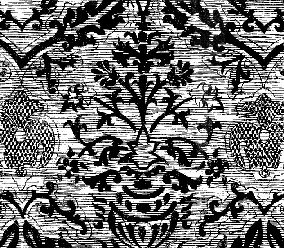The development in design of silk fabrics in Sicily shows how the influences spread from further east, in the same way as the sgraffito technique and the motifs that accompanied it also spread from the east (see Section 7). In 12th-century Sicily, designs for silk featured fabulous animals and birds, sunbursts and emblematic plants. The use of heraldic and Christian elements mainly resulted from the influence of the Crusaders. By the late 14th/early 15th century, the motifs became more floriated. In 16th-century Italy, the pineapple was common, often with pomegranates (Ward 1897, 310-12).

Figure 9: Silk damask, Florentine, 15th century (after Ward 1897, 313)
After the Dissolution in England, new aesthetic ideas were generated in the secular world. Henry VIII encouraged Italian decorators and sculptors to come to England. They introduced columns, strapwork, grotesque animals and arabesque foliage. The first influences came from Italy; the second wave from Flanders, France and Germany (Elsdon 1981, 18).
In France, the silk weaving industry was first established at Lyons in the mid-16th century. The designs were mainly floral with realistic flowers and foliage (Ward 1897, 315).
Trade with the Levant in the late 16th century led to the importation of many plants from the East. Gesner, a Swiss naturalist, saw the first tulip in flower in Augsberg in 1559 and published the first picture of it in 1561 (Evans 1931, 78). By 1634 tulips were being cultivated in Holland (ibid, 78).
Pattern-engravers in the late 16th and early 17th century used botanical themes and published pattern books. From the turn of the 17th century, there was a great increase in the volume of publications with engravings of flowers. By 1623 flower patterns dominated the minor arts (ibid, 79).
© Internet Archaeology URL: http://intarch.ac.uk/journal/issue16/1/ch6.31.html
Last updated: Wed Mar 24 2004